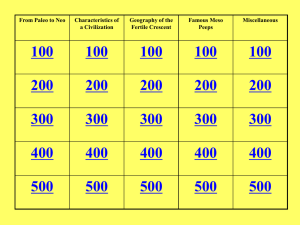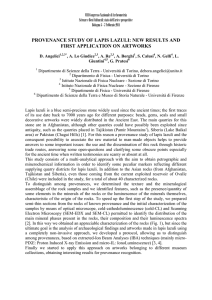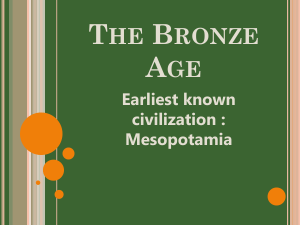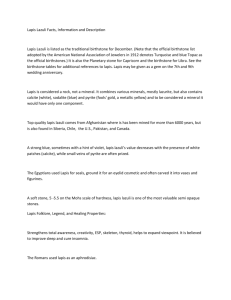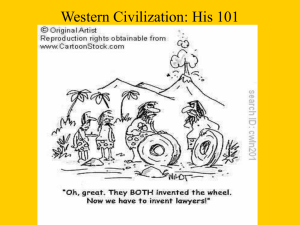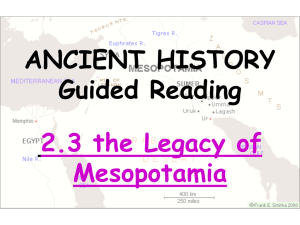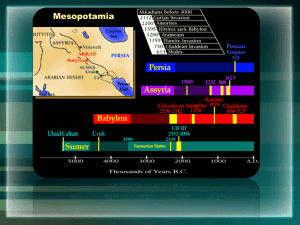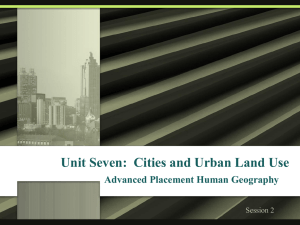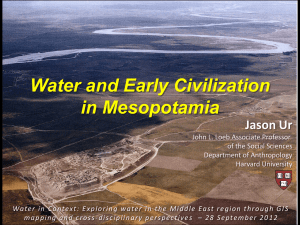The Epic of Gilgamesh - Robert B. Fitzpatrick, PLLC
advertisement
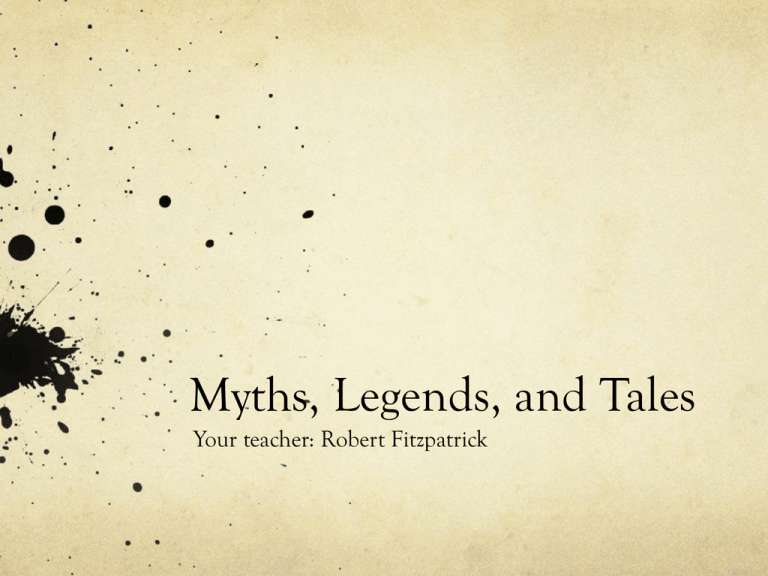
Myths, Legends, and Tales Your teacher: Robert Fitzpatrick Class Rules Only one person talks at a time. When somebody speaks in class, be a respectful, engaged listener. Use the bathroom before class. Treat others and your surroundings as you would like to be treated. Be a positive class participant at all times. Ziggurats Ziggurats were massive structures built in the Mesopotamian valley. Each was part of a temple complex that included other buildings. Unlike the pyramids, ziggurats were not tombs. Behistun Rock Inscriptions The key to translating Akkadian was discovered by Henry Rawlinson. Rawlinson heard of inscriptions carved into a rock cliff 300 feet in the air. He investigated, and discovered over 1,000 lines of cuneiform inscriptions written in three languages. The inscriptions were at Behistun in northwest Iran. Behistun Rock Inscriptions Rawlinson risked his life many times to copy the inscriptions. He published his findings in 1846, allowing translations of Akkadian inscriptions throughout Mesopotamia. Henry Rawlinson Falling Off the Behistun Rock Face The Wheel Evidence of wheeled vehicles appeared in the 4th millennium B.C./B.C.E. nearly simultaneously in Mesopotamia, the Northern Caucuses and Central Europe. No one knows which culture discovered the wheel first. The Arch Arches appeared as early as the 2nd millennium B.C./B.C.E. in Mesopotamian brick architecture. The Arch of Ctesiphon Ctesiphon was one of the great cities of ancient Mesopotamia, located on the east bank of the Tigris river. Today, in modern Iraq, a great arch from ancient Mesopotamian times still stands. The Dome People around the world have been building domes for millennia, but the development of more sophisticated domes built with enduring materials is not well documented. Barrel Vault A barrel vault is a structure consisting of a continuous surface of semicircular or pointed sections. It resembles a barrel or tunnel. Barrel vaults were used in ancient Mesopotamia and ancient Egypt. Bronze Age The Bronze Age came after the Stone Age but before the Iron Age. Bronze Age Bronze is a metal alloy consisting primarily of copper, with tin as the main additive. Bronze dates to the late fourth millennium B.C./B.C.E. Origins of Tin and Copper Archaeologists have not yet been able to determine where the tin used in Mesopotamia came from. Maybe as far away as the Indus Valley. Copper mines have been operational in what is now known as Oman since 2000 B.C./B.C.E. Tin Ore Copper Ore Sumerian Metal Casting Metal casting is a manufacturing process in which liquid metal is poured into a mold and allowed to solidify. People have been using this technique for 6000 years, starting with copper and tin to make bronze. Cylinder Seal A cylinder seal is a cylinder engraved with a pictures story, used in ancient times to roll an impression onto a twodeimensional surface, usually wet clay. Cylinder seals were invented around 3500 B.C./B.C.E. in southern Mesopotamia. War Chariots The ancient Sumerians used chariots in battle against their enemies. The Winged Bull of Nineveh A Lamassu is a Sumerian protective deity, often depicted with a bull or lion’s body, eagle’s wings, and a human head. The Great Fatted Bull The Great Fatted Bull is a story written on a tablet in Mesopotamia around 2000 B.C. The story is part murder mystery, part political satire, and entirely written in code! Luckily, the author left a key to the code imbedded in the story itself. Ningishzida Ningishzida is a Mesopotamian deity of the underworld. His name in Sumerian is translated as “lord of the good tree.” Ningishzida is the earliest known symbol of snakes twining around a rod. A River Delta The Tigris and Euphrates join north of the Persian Gulf, and flow now as one river into the Gulf, creating a delta called the Shatt al-Arab Delta. Changing Geography – The Tigris/Euphrates Delta As silt flows down the Tigris and Euphrates rivers, it settles where the rivers meet the Persian Gulf. Over the centuries, the land has grown as more and more silt is deposited. The ancient city of Ur used to be on the coast, but now it is about 120 miles inland. Tigris and Euphrates Trade Routes Origin of Deltas Why do we call these river deltas? Because it resembles the three sided letter of the Greek alphabet named delta. The Ancient Middle East Sumerian City-States The Death Pits of Ur In the 1920s and 30s, Leonard Woolley discovered around 2,500 graves at the ancient city of Ur in Mesopotamia. Woolley discovered that the elite of Ur were buried with an impressive quantity of precious goods, as well as members of their household. In one “death pit,” Woolley discovered 6 male and 68 female servants, many dressed up for the big day. The First Known Board Game Players of the game of Ur took the rules to their graves 4,500 years ago. We’ll never know how to play the world’s oldest known board game. Archaeologists guest by asking questions: Do the game pieces look like any modern pieces? How many kinds of pieces are there? Based on the pieces, how many players were there? Is the board a track? Where does it start and end? The dice are pyramids with two out of for corners marked. How do they work? Did backgammon evolve from this game? Carbon-14 Dating Carbon-14 dating is a method of determining estimated ages for organic materials. It was introduced in 1949 by Dr. Willard Libby. Carbon-14 exists in all organic material, and decays over time. We can determine how long something has existed by measuring how much the Carbon-14 has decayed. Sexagesimal System The Sexagesimal System is a base-60 system of counting. We count time using a base-60 system. Sexagesimal System An ancient currency known as shekels were counted using a base-60 system. 60 shekels = 1 mina (about a pound). 60 minas = 1 talent. 180 barleycorns = 1 shekel. Agriculture The Sumerians had a “salinization” problem. Evaporating salt water left behind layers of salt, and the salt made it difficult to grow wheat. Sumerians wrote of the whole earth turning white with salt. By 1800 B.C./B.C.E., salinzation had greatly diminished agriculture in southern Mesopotamia. Barley is more tolerant of salt then wheat, so the Sumerians began growing more barley. The Great Flood George Smith and the Great Flood The Great Flood The Great Flood - Geography The Strait of Gibraltar is very narrow. The strait, which separates Europe and Africa, is just 9 miles wide at its narrowest point. The Great Flood - Geography The Bosporus and the Dardanelles: The Great Flood - Geography The currents of the Bosporus flow in two different directions. The current at the top of the water flows north to south, while the current at the bottom flows south to north. The Great Flood - Geography The Great Flood - Geography The Royal Road The Royal Road was an ancient highway built by the Persians in the 5th Century B.C./B.C.E. It stretched from the Mediterranean Sea east all the way to the Hindu Kush. Lapis Lazuli Lapis Lazuli has been collected form the mines of the Badakhshan province of Afghanistan for over 6000 years. Marco Polo visited Badakhshan during his travels. Vermeer and Lapis Lazuli Here are two masterpieces painted by Johannes Vermeer using paint made from lapis lazuli: Young Woman With a Water Pitcher, ca. 1662 Woman in Blue Reading a Letter, ca. 1662-63 Lapis Lazuli Lapis Lazuli Lapis Lazuli Lapis Lazuli Lapis Lazuli Trade Routes Carnelian Carnelian is a brownish-red mineral which is commonly used as a semi-precious gemstone. Carnelian has been used for decorative purposes dating back to 1800 B.C./B.C.E. Beards Sumerian men devoted great care to oiling and dressing their beards, using tongs and curlers to create elaborate ringlets and tiered patterns. Dreads Dreads Marsh Arabs The “Marsh Arabs” are inhabitants of the TigrisEuphrates marshlands. Scorpion-Man and His Wife Scorpion-Man was the guard to the door where the sun went at night. He told Gilgamesh not to walk through the door because it was 12 leagues and it was very, very dark. Ut-napishtim and His Wife Ut-napishtim was the only man ever made immortal, but he was not the only person. Ut-napishtim’s wife was also made immortal, but her name never appears in Ut-napishtim’s story or elsewhere. Ishtar Ishtar is the Assyrian and Babylonian goddess of fertility, love, and war. Enheduanna: The World’s First Known Poetess Enheduanna was named by her father, Sargon, to be the high priestess of An, the god of heaven at Uruk, and Nanna, the moon god at Ur. Sargon named Enheduanna the high priestess of both gods to reconcile the Sumerians and Akkadians in his empire. Enheduanna was so successful that Sumerian kings after Sargon continued to appoint their daughters as priestesses of Ur and Uruk. Yazidi The Yazidi are members of a Kurdish religion living in northern Iraq. Yazdanism blends elements of pre-Islamic Mesopotamian religious traditions with Christianity and Islam. Zoroastrianism Zoroastrianism was once one of the world’s largest religions. It was founded before the 6th century B.C./B.C.E. based on the teachings of the prophet Zoroaster in Persia. The symbols of Zoroastrianism are the serpent and peacock. Sumerian Language Sumerian is the language of ancient Sumer, which was spoken in Mesopotamia since at least the 4th Millennium B.C./B.C.E. To the right is a tablet carved with Sumerian text. It is a letter from the high-priest Lu’enna to the king of Lagash telling the king that his son died in combat. Sumerian is called an “isolate” language, as it is not related to any other language. The Sumerian language is extinct. Birthstones Birthstones originated when each of the twelve tribes of ancient Israel was assigned a particular stone as an identifying stone on the high priest’s breastplate. Over time, the stones lost their meaning and became “birthstones.” The Nile Delta The Nile Delta The Nile River flows from south to north into the Mediterranean Sea, creating a delta. The Nile Delta The Nile Delta Papyrus scrolls from the library at Alexandria Cleopatra
